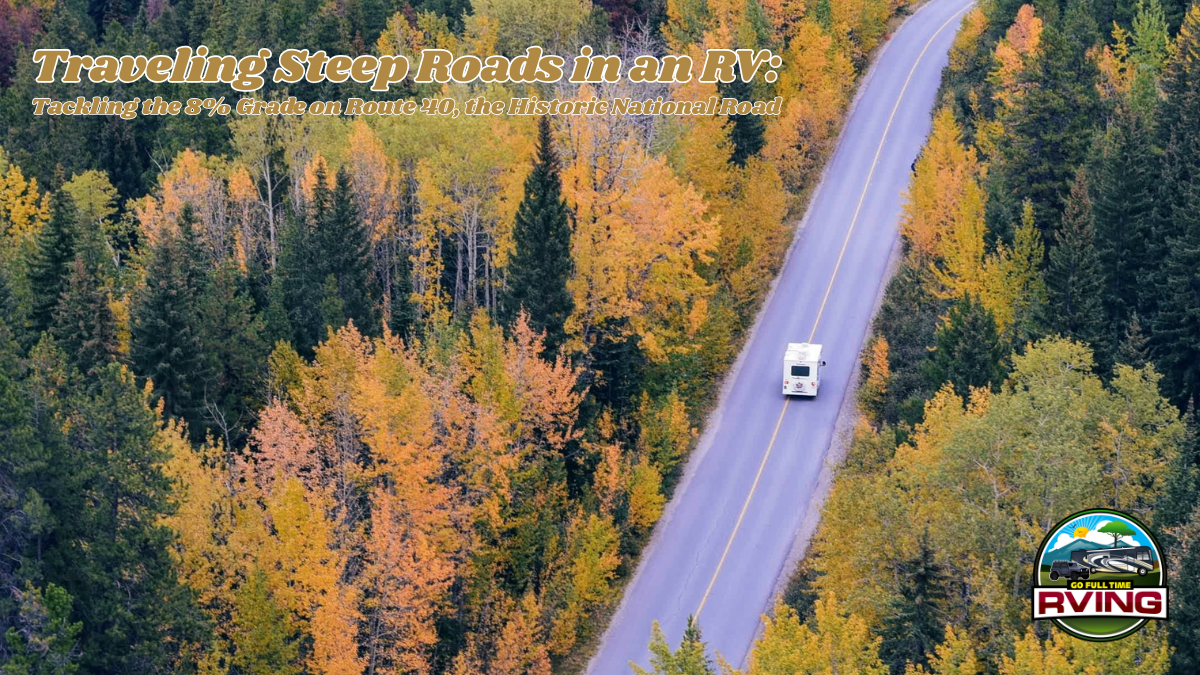Traveling steep roads in an RV can be one of the most challenging — and rewarding — parts of life on the road. Every RVer has a story about a white-knuckle descent, that moment when gravity takes over and your brakes become your best friend (or worst enemy).
For us, one of those moments came while driving Route 40 through Pennsylvania, a stretch of highway that’s both beautiful and demanding. Known as the National Road, this route features a daunting 8% grade that tests both driver skill and rig setup.
If you’re planning to drive this historic route in your motorhome, fifth wheel, or travel trailer, preparation is everything. Here’s what we learned about tackling steep grades safely while soaking in one of America’s most storied highways.
This post contains affiliate links. As a participant in Amazon Associates and various affiliate programs, we are compensated when qualifying purchases are made through our referral links at no additional cost to you. Full Disclosure
The National Road: America’s First Highway
Before the interstate system or even the Lincoln Highway, there was the National Road — America’s very first federally funded highway. Authorized by Congress in 1806, it was built to connect the Potomac and Ohio Rivers and eventually stretched from Cumberland, Maryland, through Pennsylvania, West Virginia, Ohio, Indiana, and into Illinois.
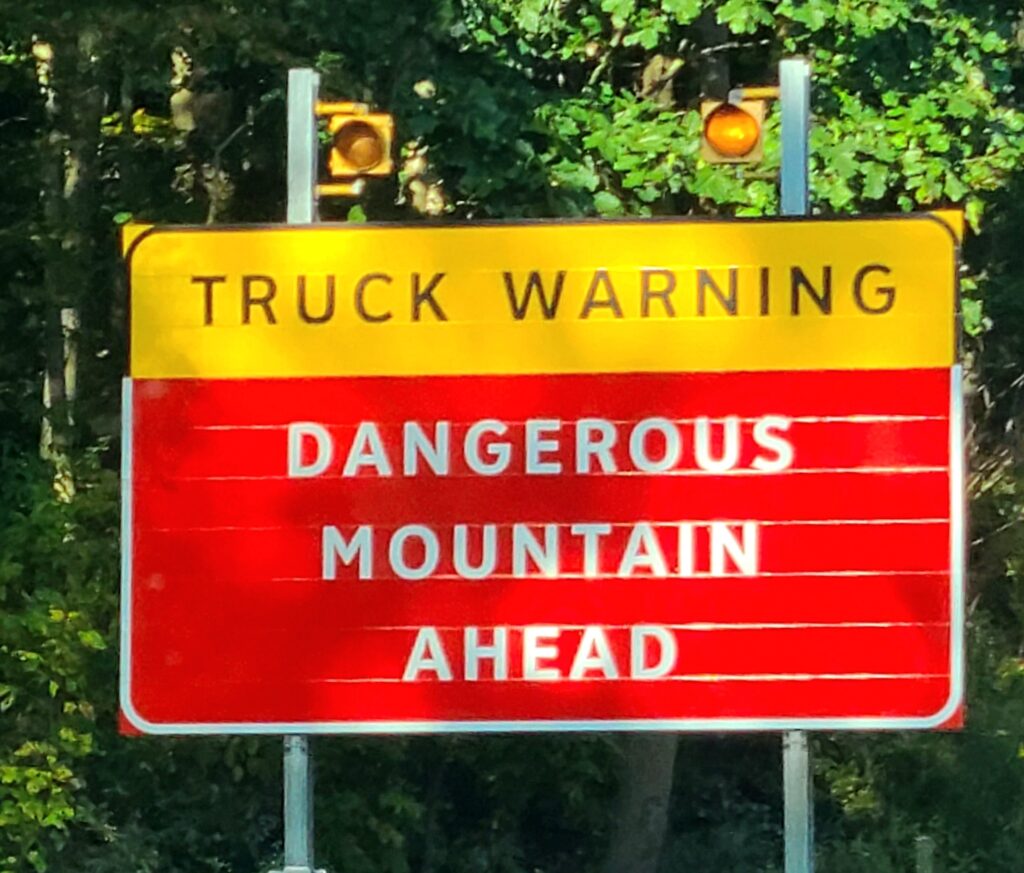

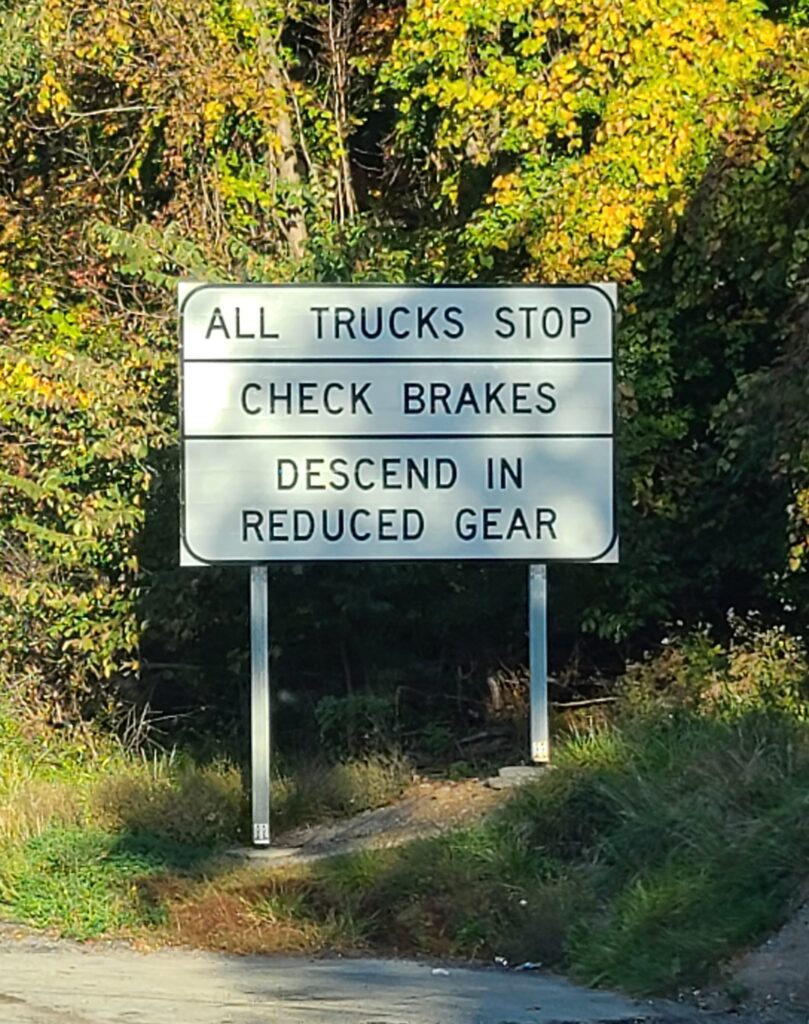
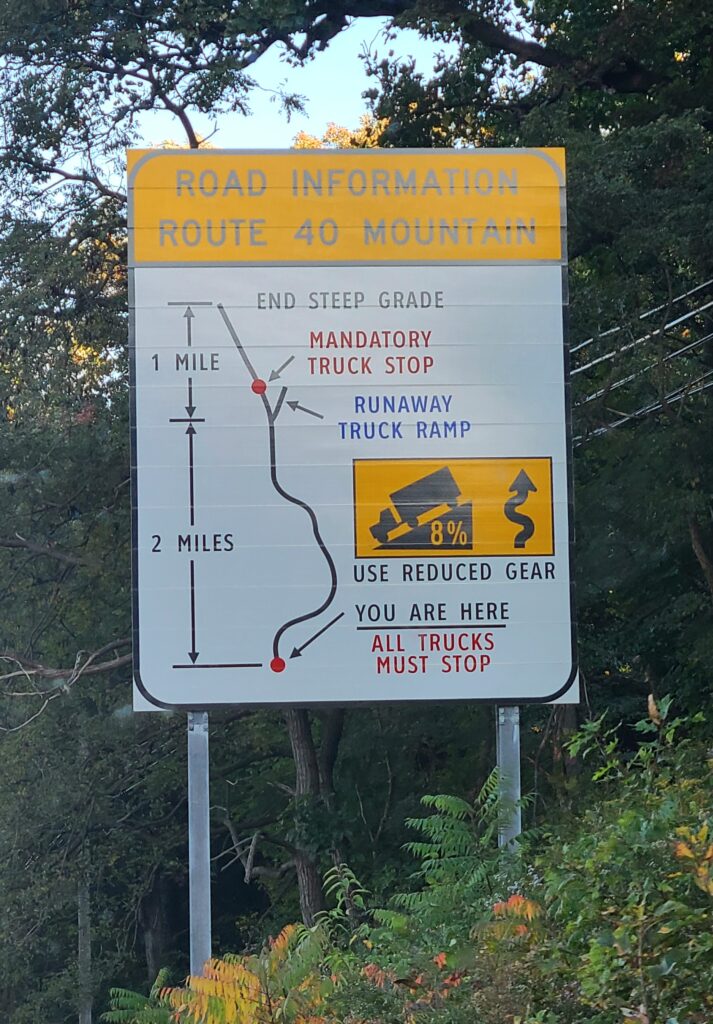
This road became a lifeline for settlers heading west, long before the automobile existed. Traveling Route 40 today, especially through Pennsylvania’s Laurel Highlands, gives you a tangible sense of that history. You’ll pass stone bridges, historic mile markers, and even remnants of early inns and taverns that once served travelers making the same journey by wagon and stagecoach.
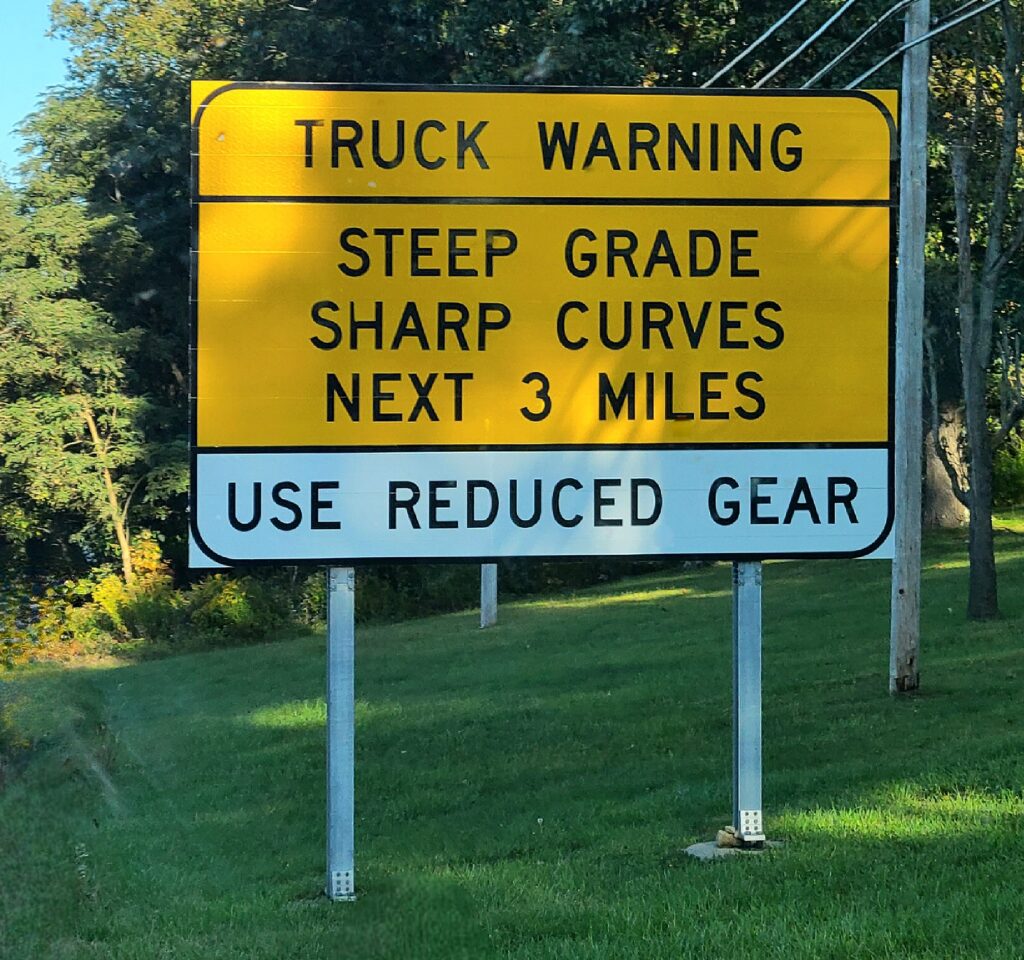

Understanding Steep Roads in an RV
A road’s grade is its incline — an 8% grade means the elevation changes eight feet for every hundred feet of distance. That might not sound like much on paper, but in a 20,000-plus-pound RV, it’s significant. Descending or climbing a grade that steep requires finesse, awareness, and a healthy respect for physics.
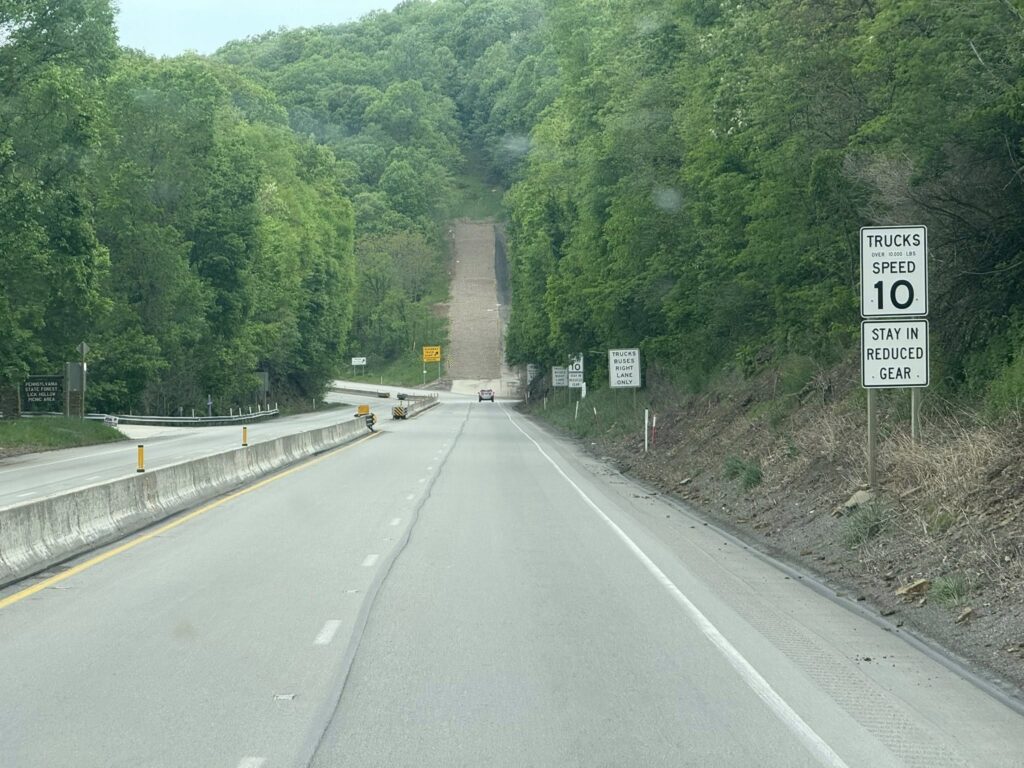
Tips for Safely Navigating Steep Grades in an RV
1. Slow Down Before You Start Downhill
Once you start your descent, momentum builds fast. Always reduce speed before reaching the crest and shift into a lower gear. Let your transmission and engine do as much of the work as possible.
2. Don’t Ride the Brakes
Riding the brakes can overheat them and cause brake fade or even failure. Instead, use stab braking — apply firm pressure to slow down 5–10 mph, then release to let them cool.
3. Use Engine or Exhaust Braking (if equipped)
If your RV has an engine brake, exhaust brake, or grade-braking mode, turn it on before starting the descent. These systems dramatically reduce strain on your braking system and help maintain control.
4. Keep a Safe Distance
Leave plenty of space between you and the vehicle ahead. If traffic suddenly slows or stops, you’ll need extra room to react.
5. Know Your Weight and Limits
Heavier rigs pick up speed faster on steep declines and require longer stopping distances. If you’re towing, make sure your trailer brakes are properly adjusted and your brake controller is dialed in.
Tips for Climbing Steep Grades in an RV
Climbing can be just as nerve-wracking as descending — only this time, the challenge is keeping your engine cool and maintaining momentum without overworking your drivetrain. Here’s what’s worked for us.
1. Build Momentum Before the Climb
As you approach the hill, gradually increase speed while keeping RPMs in a comfortable range. A little momentum makes a big difference.
2. Downshift Early
Just like descending, gear selection is key. Downshift before you lose too much speed to prevent gear hunting. Let the engine stay in its power band — that’s where it pulls strongest.
3. Watch Your Temperature Gauges
Your engine and transmission temps rise quickly on long climbs. If either starts creeping up, pull over safely to let things cool. Many RVers add transmission temperature gauges or use OBD monitors like the ScanGauge II to track data.
4. Turn Off the A/C
It’s not fun on a hot day, but shutting off the air conditioning lightens the engine load and helps control temps.
5. Maintain a Steady Throttle
Avoid sudden throttle changes or flooring it — smooth, steady pressure keeps the transmission from constant shifting and saves fuel.
6. Use the Right Lane
Stay to the right, use flashers if needed, and let faster traffic pass. Safety and consistency matter more than speed.

A Note About the Ford F53 Chassis
Our 2019 Thor Challenger is built on the Ford F53 chassis and powered by the Triton V10 engine. It’s a solid combination for mountain driving, provided you use it wisely. The V10 has plenty of torque for climbing, but it likes to rev — don’t be afraid to let it run in the 3,000–4,500 RPM range on long grades.
I always engage Tow/Haul mode and let the transmission manage most of the gear changes. That mode holds gears longer on climbs and downshifts earlier on descents, helping control both power and braking.

It definitely won’t win any races on the uphill, but it keeps pace with the semi trucks, and that’s good enough for us. Between the engine’s power and the F53’s compression braking on descents, it’s a dependable setup for RVers tackling mountainous terrain.
Our Experience on Route 40
Over the years, we’ve tackled plenty of steep grades — from the winding roads of the West Coast to the high mountain passes of Colorado — but the National Road in Pennsylvania is probably the steepest stretch we’ve ever driven. The 8% grade along Route 40 through the Laurel Highlands demands respect and patience.
Our motorhome’s compression braking helped immensely. Before starting the descent, I dropped the transmission into a lower gear and let the system handle most of the work. The key was resisting the urge to ride the brakes — using short, firm applications instead when necessary.
By the time we reached the bottom, the brakes were cool, the rig was steady, and my appreciation for both the National Road’s engineering and the F53’s downhill performance had grown tenfold.
Recommended Gear for Steep Grades
When you’re facing serious climbs and descents, a few key products make a world of difference:

- Tire Pressure Monitoring System (TPMS): We use and recommend the TST 507 TPMS — it alerts you to temperature and pressure changes that can indicate brake or tire issues.
- Engine Braking Assist: If your RV or tow vehicle supports it, turn it on before the descent. For diesel pushers, an exhaust brake is worth every penny.
- RV-Specific GPS: The Garmin RV 895 or 1095 helps avoid routes with severe grades or weight limits.
Having the right tools in place gives you peace of mind before the next mountain pass.

Lesson Learned
Every steep grade we’ve faced — from the switchbacks of Colorado to the rolling mountains of Pennsylvania — has taught us something new about patience, preparation, and trust in our rig.
Driving the National Road reminded us that RV travel isn’t just about the miles you cover, but how you handle the journey along the way. Whether it’s easing down an 8% grade or grinding up a long climb, each challenge adds confidence and experience that you’ll carry into the next adventure.
I always say, “Difficult roads often lead to beautiful destinations.” And that couldn’t be truer for RV life. Every uphill effort and cautious descent brings you somewhere worth seeing — and that’s what keeps us rolling.
Final Thoughts
Traveling steep roads in an RV isn’t something to fear — it’s something to respect and prepare for. Routes like the National Road blend American history with modern-day driving challenges.
Take it slow, use your gears wisely, and enjoy the ride. Every climb and descent teaches you something new about your rig, your confidence, and the road ahead.
If you’re looking to build your own home-based business like we have with this webpage, check out Wealthy Affiliate.
Wealthy Affiliate is an all-in-one platform that you can build your whole affiliate marketing business on. It combines training, software, and website hosting into one. This makes the whole process of starting an online business from scratch much easier, especially if you’re new to building a website.


